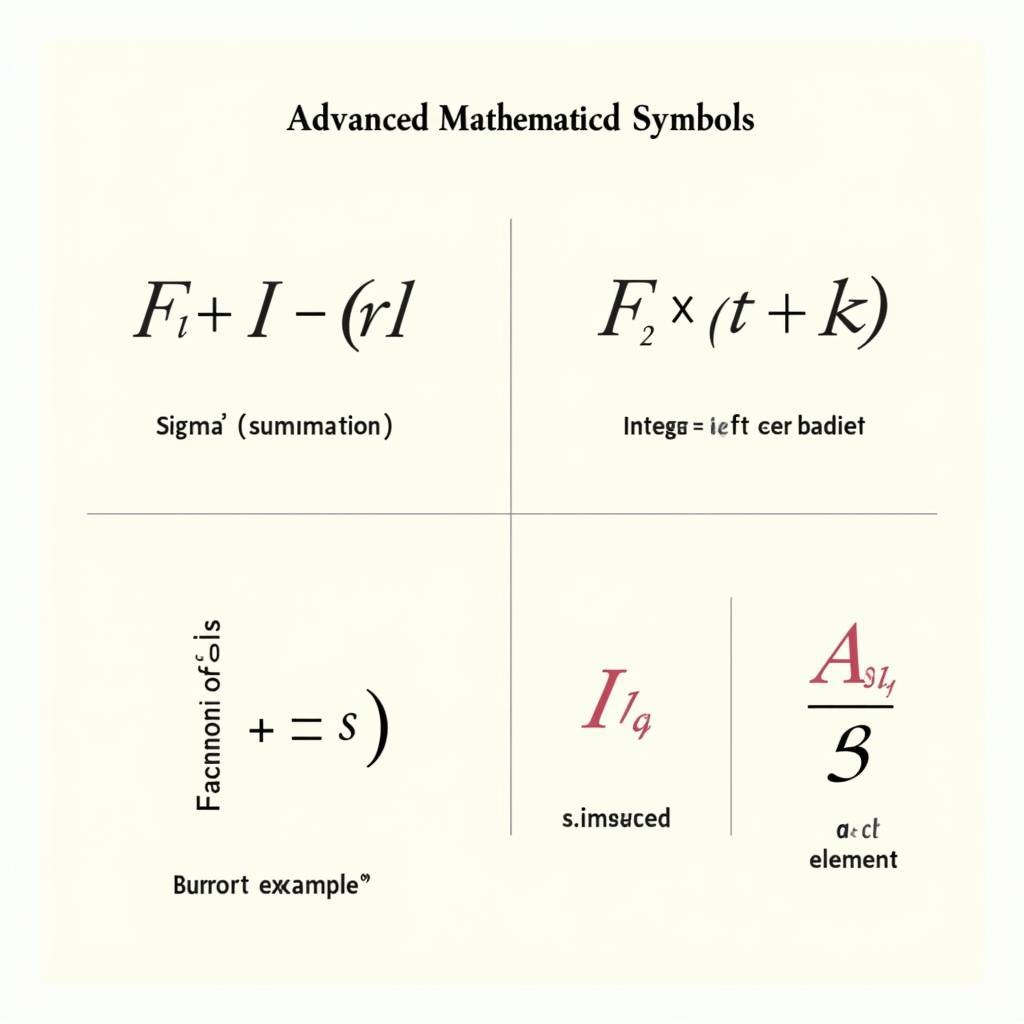Mathematical symbols in English can seem daunting at first, but with a little practice, they become a powerful tool for understanding and expressing complex ideas. This guide will provide you with a comprehensive understanding of common mathematical symbols, their meanings, and how to use them effectively.
Common Mathematical Symbols and Their Meanings
Let’s start with the basics. Many mathematical symbols are derived from Greek and Latin alphabets, reflecting the historical development of mathematics. Understanding these origins can help you remember them more easily.
- + (Plus): Indicates addition. For example, 2 + 3 = 5.
- – (Minus): Indicates subtraction. For example, 5 – 2 = 3.
- × or · (Multiplication): Indicates multiplication. For example, 2 × 3 = 6 or 2 · 3 = 6. The “×” symbol is more common in elementary math, while the “·” (dot) becomes more prevalent in higher levels.
- ÷ or / (Division): Indicates division. For example, 6 ÷ 2 = 3 or 6 / 2 = 3.
- = (Equals): Indicates equality between two expressions. For example, 2 + 2 = 4.
- ≠ (Not Equal to): Indicates that two expressions are not equal. For example, 2 ≠ 3.
- < (Less than): Indicates that the left side is less than the right side. For example, 2 < 3.
- > (Greater than): Indicates that the left side is greater than the right side. For example, 3 > 2.
- ≤ (Less than or equal to): For example, x ≤ 5 means x can be any number 5 or less.
- ≥ (Greater than or equal to): For example, x ≥ 5 means x can be any number 5 or more.
- ∞ (Infinity): Represents a concept that is boundless or endless.
- π (Pi): Represents the ratio of a circle’s circumference to its diameter, approximately 3.14159.
- √ (Square root): Indicates the square root of a number. For example, √9 = 3.
- % (Percent): Represents a proportion or fraction out of 100. For example, 50% means 50 out of 100.
Navigating Advanced Mathematical Symbols
As you progress in your math studies, you’ll encounter more complex symbols. These symbols represent advanced concepts in algebra, calculus, and other branches of mathematics.
- ∑ (Sigma): Used for summation, or the adding up of a sequence of numbers.
- ∫ (Integral): Used in calculus to represent integration.
- ! (Factorial): The product of all positive integers less than or equal to a given number. For example, 5! = 5 × 4 × 3 × 2 × 1 = 120.
- ∅ (Empty set): Represents a set with no elements.
- ∈ (Element of): Indicates that an object is a member of a set.
- ∉ (Not an element of): Indicates that an object is not a member of a set.
- ⊂ (Subset): Indicates that one set is contained within another set.
 Advanced Mathematical Symbols
Advanced Mathematical Symbols
Interested in learning a new skill? Consider learning to play the guitar. Check out our recommended app học đàn guitar.
Why Learning Mathematical Symbols is Important
Mastering mathematical symbols in English is crucial for several reasons.
- Clear Communication: They provide a concise and universally understood way to express mathematical ideas.
- Problem Solving: They enable you to translate word problems into mathematical equations and solve them effectively.
- Higher Education: A strong grasp of mathematical symbols is essential for success in STEM fields.
Are you thinking about studying abroad? Learn about du học ngành công nghệ thực phẩm or du học nghề úc ngành công nghệ thông tin.
Conclusion
Understanding mathematical symbols in English unlocks the door to a deeper understanding of mathematics. This guide has provided you with a solid foundation to build upon. By continuing to practice and explore these symbols, you can enhance your mathematical fluency and open up a world of possibilities. Remember, mastering these symbols is a journey, not a destination. Continue learning and exploring!
FAQ
- What does the symbol π represent? (Pi represents the ratio of a circle’s circumference to its diameter.)
- What is the symbol for infinity? (The symbol for infinity is ∞.)
- What does the symbol ∑ mean? (∑ represents summation.)
- How do I use the factorial symbol? (The factorial symbol (!) is placed after a number and represents the product of all positive integers less than or equal to that number.)
- Why are mathematical symbols important? (Mathematical symbols are important for clear communication, problem-solving, and higher education.)
- What does the symbol √ mean? (√ represents the square root of a number.)
- What is the difference between < and ≤? (< means less than, while ≤ means less than or equal to.)
Wondering about the cost of IELTS preparation? Find out more about 1 khóa học ielts bao nhiêu tiền. Are you considering FPT High School? See if it’s the right fit for you: có nên học trường thpt fpt.
Need further assistance? Contact us at 0705065516, thptquangtrung@gmail.com, or visit us at NB tổ 5/110 KV bình thường b, P, Bình Thủy, Cần Thơ, Việt Nam. Our customer service team is available 24/7.

